Internet of Things: User Interface, Cables, and Security Analysis
VerifiedAdded on 2020/03/01
|8
|2044
|48
Report
AI Summary
This report provides a comprehensive overview of the Internet of Things (IoT), exploring various facets of its technological landscape. The report begins by examining the concept of user interfaces, arguing for a shift towards "no user interface" approaches that leverage sensors and natural interactions. It then delves into the different types of cables used in IoT, including twisted pair, coaxial, and fiber optic cables, detailing their functionalities and applications. The report also addresses crucial security and privacy concerns within the IoT ecosystem, highlighting potential threats and mitigation strategies. Furthermore, it discusses communication models, comparing the command/response approach with the publish/subscribe model, and analyzes the implications of Nielsen's Law and Moore's Law on IoT. Finally, the report references key publications and research papers to support its arguments and findings.
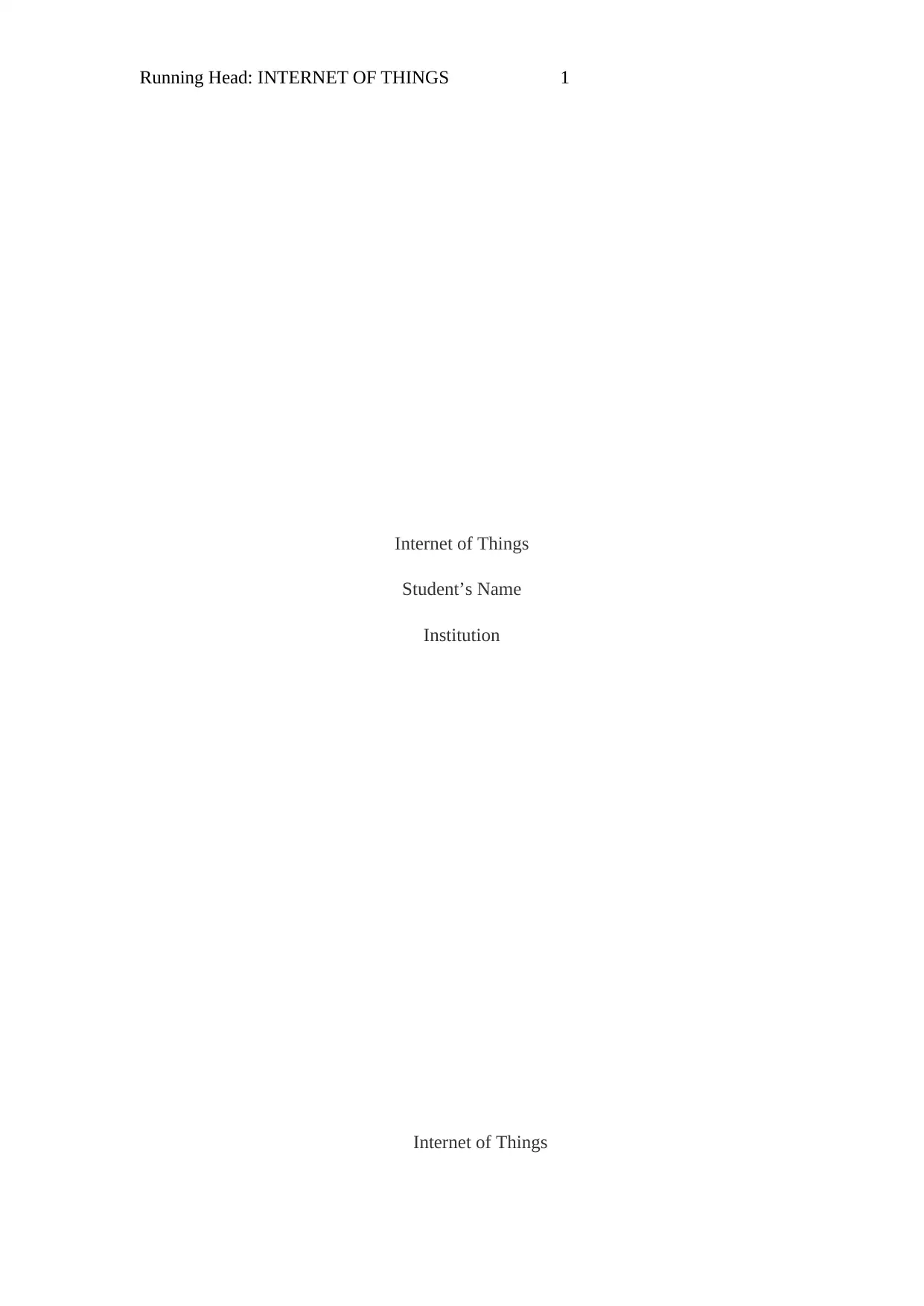
1Running Head: INTERNET OF THINGS
Internet of Things
Student’s Name
Institution
Internet of Things
Internet of Things
Student’s Name
Institution
Internet of Things
Paraphrase This Document
Need a fresh take? Get an instant paraphrase of this document with our AI Paraphraser

2INTERNET OF THINGS
Question 1
User interface is a space in which computer and human interaction occur. The
user interface is usually designed to ensure that the user gets the most out of
interacting with a machine. The purpose of the user interface is ensure a human can be
able to operate the machine with ease and the machine can be able to give correct
responses based on input from the user. We know that a user interface allows human
beings to easily and effectively operate a machine and yet it is being said that the best
interface for a system is no user interface. User interfaces were created to help
humans easily communicate with machines. Before we had graphical user interfaces
we had other ways of communicating with fellow human beings which was better and
very convenient (Wseas, 2010). It was by the use of gestures, speech, sensors and
interaction with one another. In order to replicate this form of interaction we need to
first ensure that a machine can understand our voices or speech and can act upon our
speech commands. A good example of such a path to embracing no user interface is
when it becomes dark in a room. A machine can be given instructions easily to
respond to the darkness by lighting up the room.
However we usually do that by instructing the machine to switch on the light. It
would be better if the machine used sensors to know whether the room was dark or
light and respond appropriately by switching the lights on or off. This is a step
towards no user interface and it is very effective because communication tends to acts
naturally as it is with how human beings communicate with each other and respond to
various conditions. Another key importance in ensuring the best interface is no
Question 1
User interface is a space in which computer and human interaction occur. The
user interface is usually designed to ensure that the user gets the most out of
interacting with a machine. The purpose of the user interface is ensure a human can be
able to operate the machine with ease and the machine can be able to give correct
responses based on input from the user. We know that a user interface allows human
beings to easily and effectively operate a machine and yet it is being said that the best
interface for a system is no user interface. User interfaces were created to help
humans easily communicate with machines. Before we had graphical user interfaces
we had other ways of communicating with fellow human beings which was better and
very convenient (Wseas, 2010). It was by the use of gestures, speech, sensors and
interaction with one another. In order to replicate this form of interaction we need to
first ensure that a machine can understand our voices or speech and can act upon our
speech commands. A good example of such a path to embracing no user interface is
when it becomes dark in a room. A machine can be given instructions easily to
respond to the darkness by lighting up the room.
However we usually do that by instructing the machine to switch on the light. It
would be better if the machine used sensors to know whether the room was dark or
light and respond appropriately by switching the lights on or off. This is a step
towards no user interface and it is very effective because communication tends to acts
naturally as it is with how human beings communicate with each other and respond to
various conditions. Another key importance in ensuring the best interface is no

3INTERNET OF THINGS
interface is that computers being very intelligent when given instructions can work
very efficiently. The most ideal case would be computers learning how to interact and
understand us rather than having us learn how to interact with them. The computers
should be able to adapt and interact with us appropriately (Richard, 2014). A good
example is cars which can be opened remotely. These cars usually need there to be a
key which can enable the command to unlock the car to be executed. When there is no
user interface the car should detect when the owner is near the car and automatically
open the door and after the owner is in the car to automatically start itself.
Question 2
Twisted pair cables are cables which have been made by twisting two conductors
on a single circuit.. The twisting of these cables is done to remove any kind of
electromagnetic interference which comes from external sources such as
electromagnetic radiation which comes from cross-talk and unshielded twisted pair
cables (McBee, Barnett & Groth , 2004). Twisted pair cable range in bandwidth
based on the use of the cables. They range from 0.4mhz which are used on telephone
lines all the way to 2000mhz which is in development for use on 40GBBASE-T
Ethernet over a single cable. This cable can run for almost 100 metres. The amount of
interference is very minimal in this cable. There are level one twisted cables which
are used on telephone lines. Level 2 cables which are used on old terminal systems
and Cat5 which are used on local area networks.
A coaxial cable is an electric cable which comprises of an inner conductor that is
surrounded by a tubular insulating layer and a tubular conducting shield. Coaxial
interface is that computers being very intelligent when given instructions can work
very efficiently. The most ideal case would be computers learning how to interact and
understand us rather than having us learn how to interact with them. The computers
should be able to adapt and interact with us appropriately (Richard, 2014). A good
example is cars which can be opened remotely. These cars usually need there to be a
key which can enable the command to unlock the car to be executed. When there is no
user interface the car should detect when the owner is near the car and automatically
open the door and after the owner is in the car to automatically start itself.
Question 2
Twisted pair cables are cables which have been made by twisting two conductors
on a single circuit.. The twisting of these cables is done to remove any kind of
electromagnetic interference which comes from external sources such as
electromagnetic radiation which comes from cross-talk and unshielded twisted pair
cables (McBee, Barnett & Groth , 2004). Twisted pair cable range in bandwidth
based on the use of the cables. They range from 0.4mhz which are used on telephone
lines all the way to 2000mhz which is in development for use on 40GBBASE-T
Ethernet over a single cable. This cable can run for almost 100 metres. The amount of
interference is very minimal in this cable. There are level one twisted cables which
are used on telephone lines. Level 2 cables which are used on old terminal systems
and Cat5 which are used on local area networks.
A coaxial cable is an electric cable which comprises of an inner conductor that is
surrounded by a tubular insulating layer and a tubular conducting shield. Coaxial
⊘ This is a preview!⊘
Do you want full access?
Subscribe today to unlock all pages.

Trusted by 1+ million students worldwide
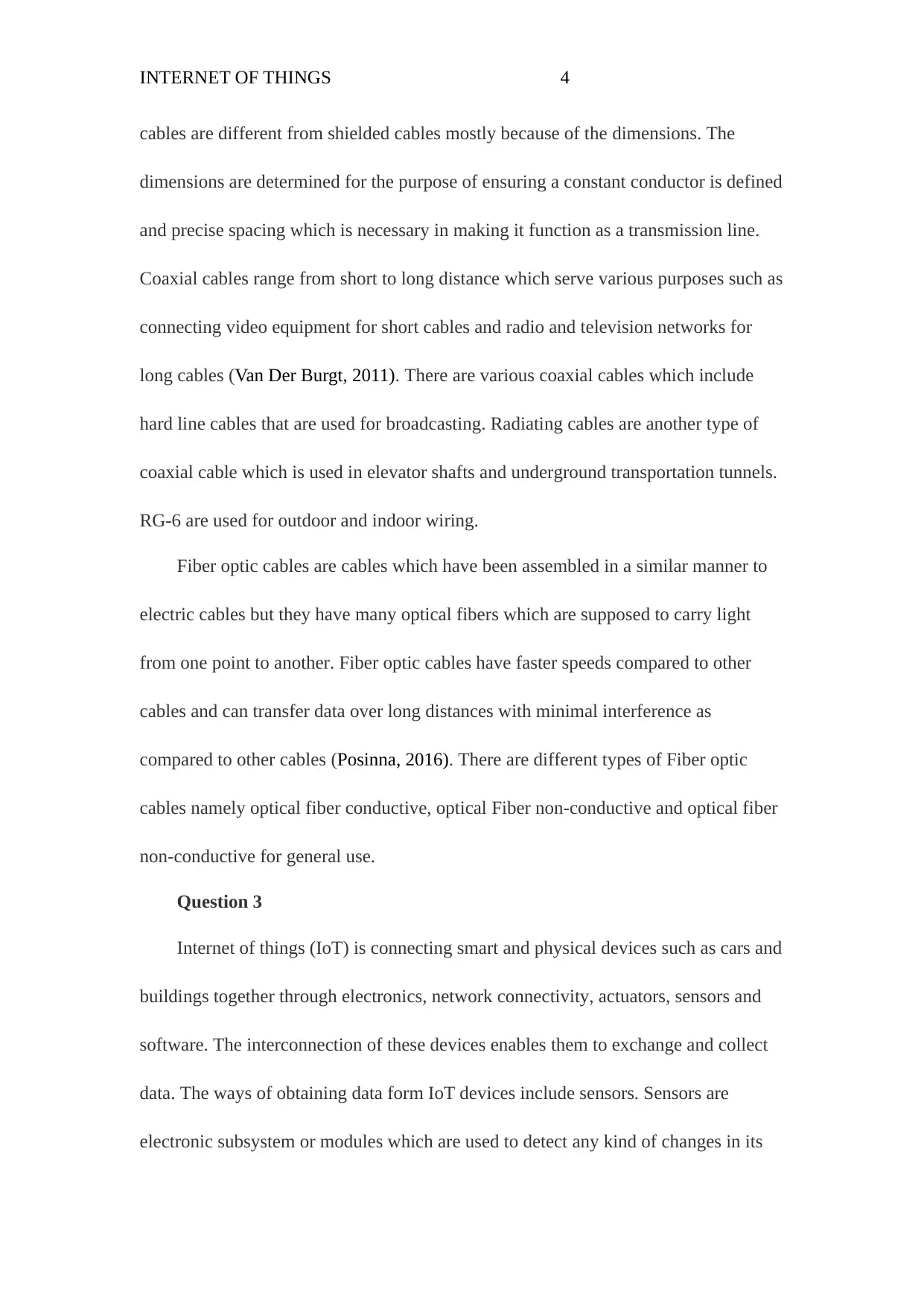
4INTERNET OF THINGS
cables are different from shielded cables mostly because of the dimensions. The
dimensions are determined for the purpose of ensuring a constant conductor is defined
and precise spacing which is necessary in making it function as a transmission line.
Coaxial cables range from short to long distance which serve various purposes such as
connecting video equipment for short cables and radio and television networks for
long cables (Van Der Burgt, 2011). There are various coaxial cables which include
hard line cables that are used for broadcasting. Radiating cables are another type of
coaxial cable which is used in elevator shafts and underground transportation tunnels.
RG-6 are used for outdoor and indoor wiring.
Fiber optic cables are cables which have been assembled in a similar manner to
electric cables but they have many optical fibers which are supposed to carry light
from one point to another. Fiber optic cables have faster speeds compared to other
cables and can transfer data over long distances with minimal interference as
compared to other cables (Posinna, 2016). There are different types of Fiber optic
cables namely optical fiber conductive, optical Fiber non-conductive and optical fiber
non-conductive for general use.
Question 3
Internet of things (IoT) is connecting smart and physical devices such as cars and
buildings together through electronics, network connectivity, actuators, sensors and
software. The interconnection of these devices enables them to exchange and collect
data. The ways of obtaining data form IoT devices include sensors. Sensors are
electronic subsystem or modules which are used to detect any kind of changes in its
cables are different from shielded cables mostly because of the dimensions. The
dimensions are determined for the purpose of ensuring a constant conductor is defined
and precise spacing which is necessary in making it function as a transmission line.
Coaxial cables range from short to long distance which serve various purposes such as
connecting video equipment for short cables and radio and television networks for
long cables (Van Der Burgt, 2011). There are various coaxial cables which include
hard line cables that are used for broadcasting. Radiating cables are another type of
coaxial cable which is used in elevator shafts and underground transportation tunnels.
RG-6 are used for outdoor and indoor wiring.
Fiber optic cables are cables which have been assembled in a similar manner to
electric cables but they have many optical fibers which are supposed to carry light
from one point to another. Fiber optic cables have faster speeds compared to other
cables and can transfer data over long distances with minimal interference as
compared to other cables (Posinna, 2016). There are different types of Fiber optic
cables namely optical fiber conductive, optical Fiber non-conductive and optical fiber
non-conductive for general use.
Question 3
Internet of things (IoT) is connecting smart and physical devices such as cars and
buildings together through electronics, network connectivity, actuators, sensors and
software. The interconnection of these devices enables them to exchange and collect
data. The ways of obtaining data form IoT devices include sensors. Sensors are
electronic subsystem or modules which are used to detect any kind of changes in its
Paraphrase This Document
Need a fresh take? Get an instant paraphrase of this document with our AI Paraphraser
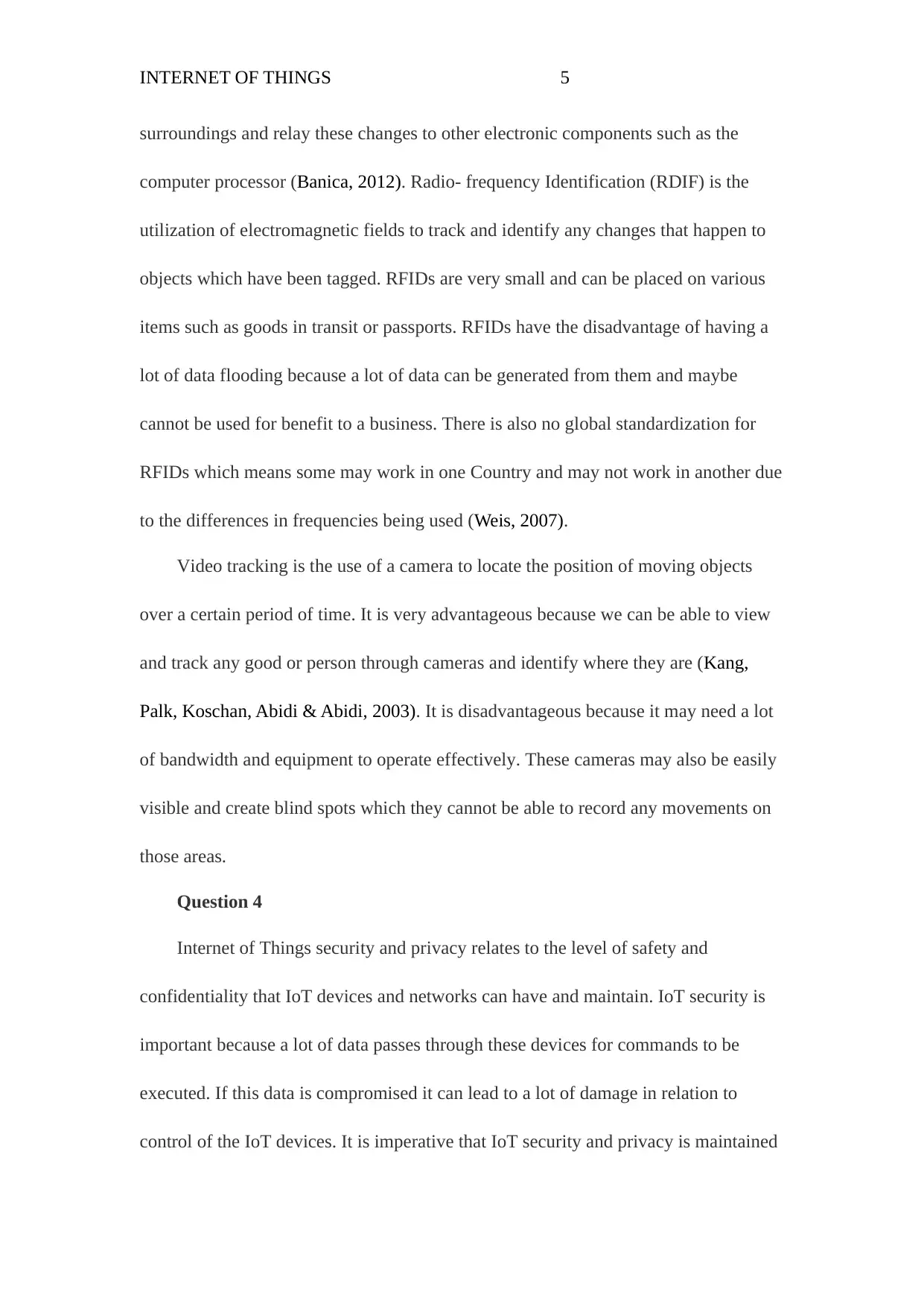
5INTERNET OF THINGS
surroundings and relay these changes to other electronic components such as the
computer processor (Banica, 2012). Radio- frequency Identification (RDIF) is the
utilization of electromagnetic fields to track and identify any changes that happen to
objects which have been tagged. RFIDs are very small and can be placed on various
items such as goods in transit or passports. RFIDs have the disadvantage of having a
lot of data flooding because a lot of data can be generated from them and maybe
cannot be used for benefit to a business. There is also no global standardization for
RFIDs which means some may work in one Country and may not work in another due
to the differences in frequencies being used (Weis, 2007).
Video tracking is the use of a camera to locate the position of moving objects
over a certain period of time. It is very advantageous because we can be able to view
and track any good or person through cameras and identify where they are (Kang,
Palk, Koschan, Abidi & Abidi, 2003). It is disadvantageous because it may need a lot
of bandwidth and equipment to operate effectively. These cameras may also be easily
visible and create blind spots which they cannot be able to record any movements on
those areas.
Question 4
Internet of Things security and privacy relates to the level of safety and
confidentiality that IoT devices and networks can have and maintain. IoT security is
important because a lot of data passes through these devices for commands to be
executed. If this data is compromised it can lead to a lot of damage in relation to
control of the IoT devices. It is imperative that IoT security and privacy is maintained
surroundings and relay these changes to other electronic components such as the
computer processor (Banica, 2012). Radio- frequency Identification (RDIF) is the
utilization of electromagnetic fields to track and identify any changes that happen to
objects which have been tagged. RFIDs are very small and can be placed on various
items such as goods in transit or passports. RFIDs have the disadvantage of having a
lot of data flooding because a lot of data can be generated from them and maybe
cannot be used for benefit to a business. There is also no global standardization for
RFIDs which means some may work in one Country and may not work in another due
to the differences in frequencies being used (Weis, 2007).
Video tracking is the use of a camera to locate the position of moving objects
over a certain period of time. It is very advantageous because we can be able to view
and track any good or person through cameras and identify where they are (Kang,
Palk, Koschan, Abidi & Abidi, 2003). It is disadvantageous because it may need a lot
of bandwidth and equipment to operate effectively. These cameras may also be easily
visible and create blind spots which they cannot be able to record any movements on
those areas.
Question 4
Internet of Things security and privacy relates to the level of safety and
confidentiality that IoT devices and networks can have and maintain. IoT security is
important because a lot of data passes through these devices for commands to be
executed. If this data is compromised it can lead to a lot of damage in relation to
control of the IoT devices. It is imperative that IoT security and privacy is maintained
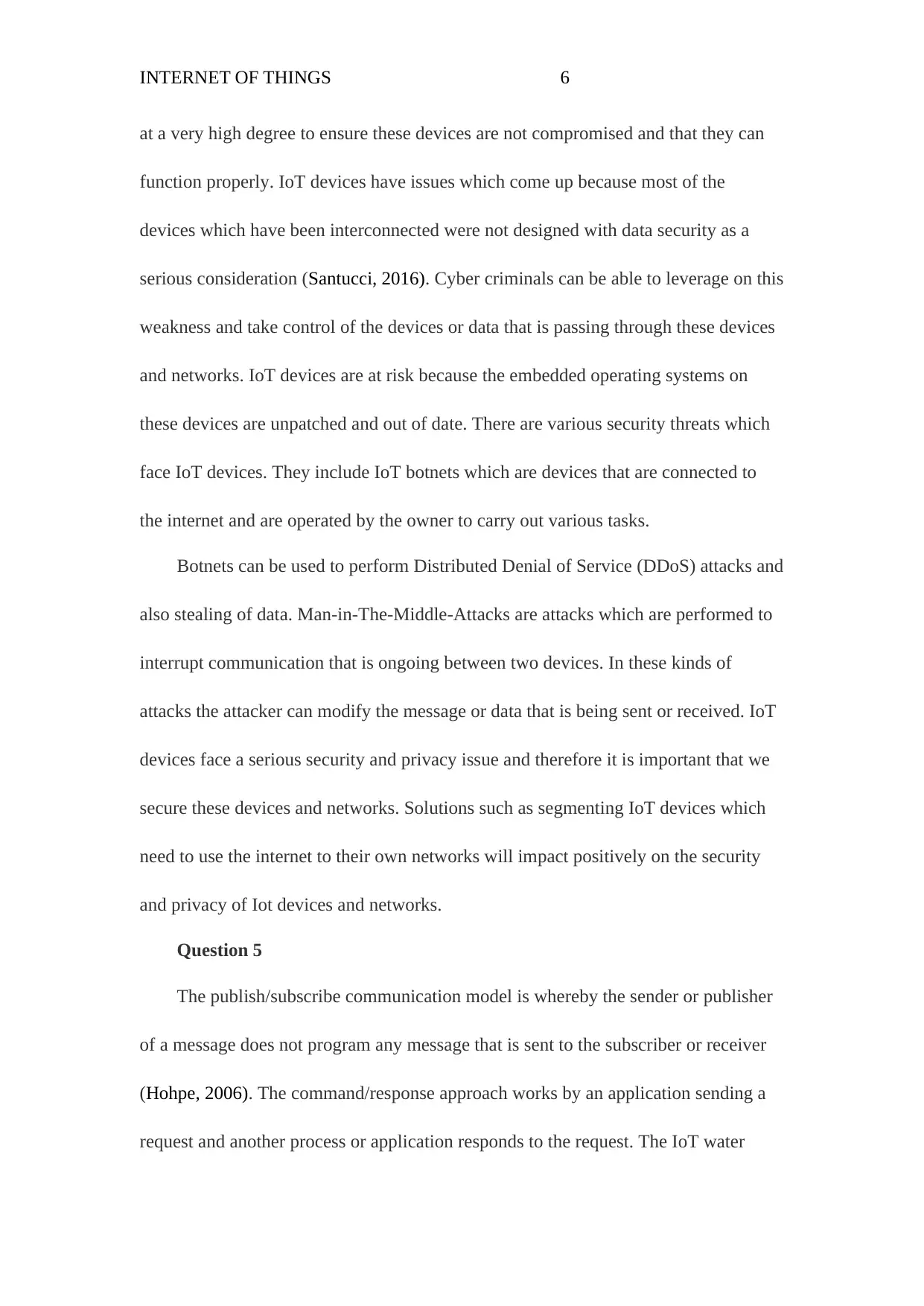
6INTERNET OF THINGS
at a very high degree to ensure these devices are not compromised and that they can
function properly. IoT devices have issues which come up because most of the
devices which have been interconnected were not designed with data security as a
serious consideration (Santucci, 2016). Cyber criminals can be able to leverage on this
weakness and take control of the devices or data that is passing through these devices
and networks. IoT devices are at risk because the embedded operating systems on
these devices are unpatched and out of date. There are various security threats which
face IoT devices. They include IoT botnets which are devices that are connected to
the internet and are operated by the owner to carry out various tasks.
Botnets can be used to perform Distributed Denial of Service (DDoS) attacks and
also stealing of data. Man-in-The-Middle-Attacks are attacks which are performed to
interrupt communication that is ongoing between two devices. In these kinds of
attacks the attacker can modify the message or data that is being sent or received. IoT
devices face a serious security and privacy issue and therefore it is important that we
secure these devices and networks. Solutions such as segmenting IoT devices which
need to use the internet to their own networks will impact positively on the security
and privacy of Iot devices and networks.
Question 5
The publish/subscribe communication model is whereby the sender or publisher
of a message does not program any message that is sent to the subscriber or receiver
(Hohpe, 2006). The command/response approach works by an application sending a
request and another process or application responds to the request. The IoT water
at a very high degree to ensure these devices are not compromised and that they can
function properly. IoT devices have issues which come up because most of the
devices which have been interconnected were not designed with data security as a
serious consideration (Santucci, 2016). Cyber criminals can be able to leverage on this
weakness and take control of the devices or data that is passing through these devices
and networks. IoT devices are at risk because the embedded operating systems on
these devices are unpatched and out of date. There are various security threats which
face IoT devices. They include IoT botnets which are devices that are connected to
the internet and are operated by the owner to carry out various tasks.
Botnets can be used to perform Distributed Denial of Service (DDoS) attacks and
also stealing of data. Man-in-The-Middle-Attacks are attacks which are performed to
interrupt communication that is ongoing between two devices. In these kinds of
attacks the attacker can modify the message or data that is being sent or received. IoT
devices face a serious security and privacy issue and therefore it is important that we
secure these devices and networks. Solutions such as segmenting IoT devices which
need to use the internet to their own networks will impact positively on the security
and privacy of Iot devices and networks.
Question 5
The publish/subscribe communication model is whereby the sender or publisher
of a message does not program any message that is sent to the subscriber or receiver
(Hohpe, 2006). The command/response approach works by an application sending a
request and another process or application responds to the request. The IoT water
⊘ This is a preview!⊘
Do you want full access?
Subscribe today to unlock all pages.

Trusted by 1+ million students worldwide
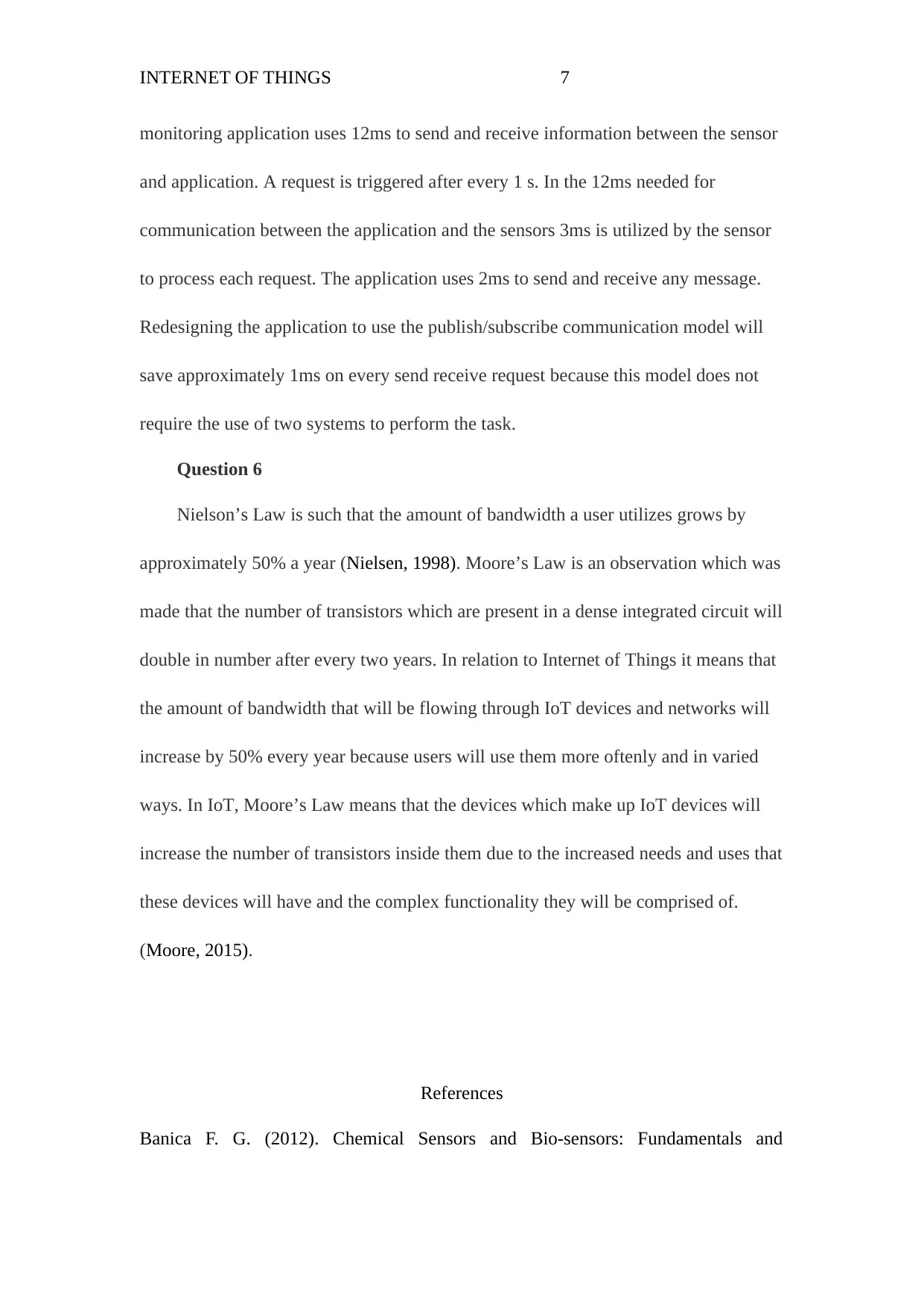
7INTERNET OF THINGS
monitoring application uses 12ms to send and receive information between the sensor
and application. A request is triggered after every 1 s. In the 12ms needed for
communication between the application and the sensors 3ms is utilized by the sensor
to process each request. The application uses 2ms to send and receive any message.
Redesigning the application to use the publish/subscribe communication model will
save approximately 1ms on every send receive request because this model does not
require the use of two systems to perform the task.
Question 6
Nielson’s Law is such that the amount of bandwidth a user utilizes grows by
approximately 50% a year (Nielsen, 1998). Moore’s Law is an observation which was
made that the number of transistors which are present in a dense integrated circuit will
double in number after every two years. In relation to Internet of Things it means that
the amount of bandwidth that will be flowing through IoT devices and networks will
increase by 50% every year because users will use them more oftenly and in varied
ways. In IoT, Moore’s Law means that the devices which make up IoT devices will
increase the number of transistors inside them due to the increased needs and uses that
these devices will have and the complex functionality they will be comprised of.
(Moore, 2015).
References
Banica F. G. (2012). Chemical Sensors and Bio-sensors: Fundamentals and
monitoring application uses 12ms to send and receive information between the sensor
and application. A request is triggered after every 1 s. In the 12ms needed for
communication between the application and the sensors 3ms is utilized by the sensor
to process each request. The application uses 2ms to send and receive any message.
Redesigning the application to use the publish/subscribe communication model will
save approximately 1ms on every send receive request because this model does not
require the use of two systems to perform the task.
Question 6
Nielson’s Law is such that the amount of bandwidth a user utilizes grows by
approximately 50% a year (Nielsen, 1998). Moore’s Law is an observation which was
made that the number of transistors which are present in a dense integrated circuit will
double in number after every two years. In relation to Internet of Things it means that
the amount of bandwidth that will be flowing through IoT devices and networks will
increase by 50% every year because users will use them more oftenly and in varied
ways. In IoT, Moore’s Law means that the devices which make up IoT devices will
increase the number of transistors inside them due to the increased needs and uses that
these devices will have and the complex functionality they will be comprised of.
(Moore, 2015).
References
Banica F. G. (2012). Chemical Sensors and Bio-sensors: Fundamentals and
Paraphrase This Document
Need a fresh take? Get an instant paraphrase of this document with our AI Paraphraser
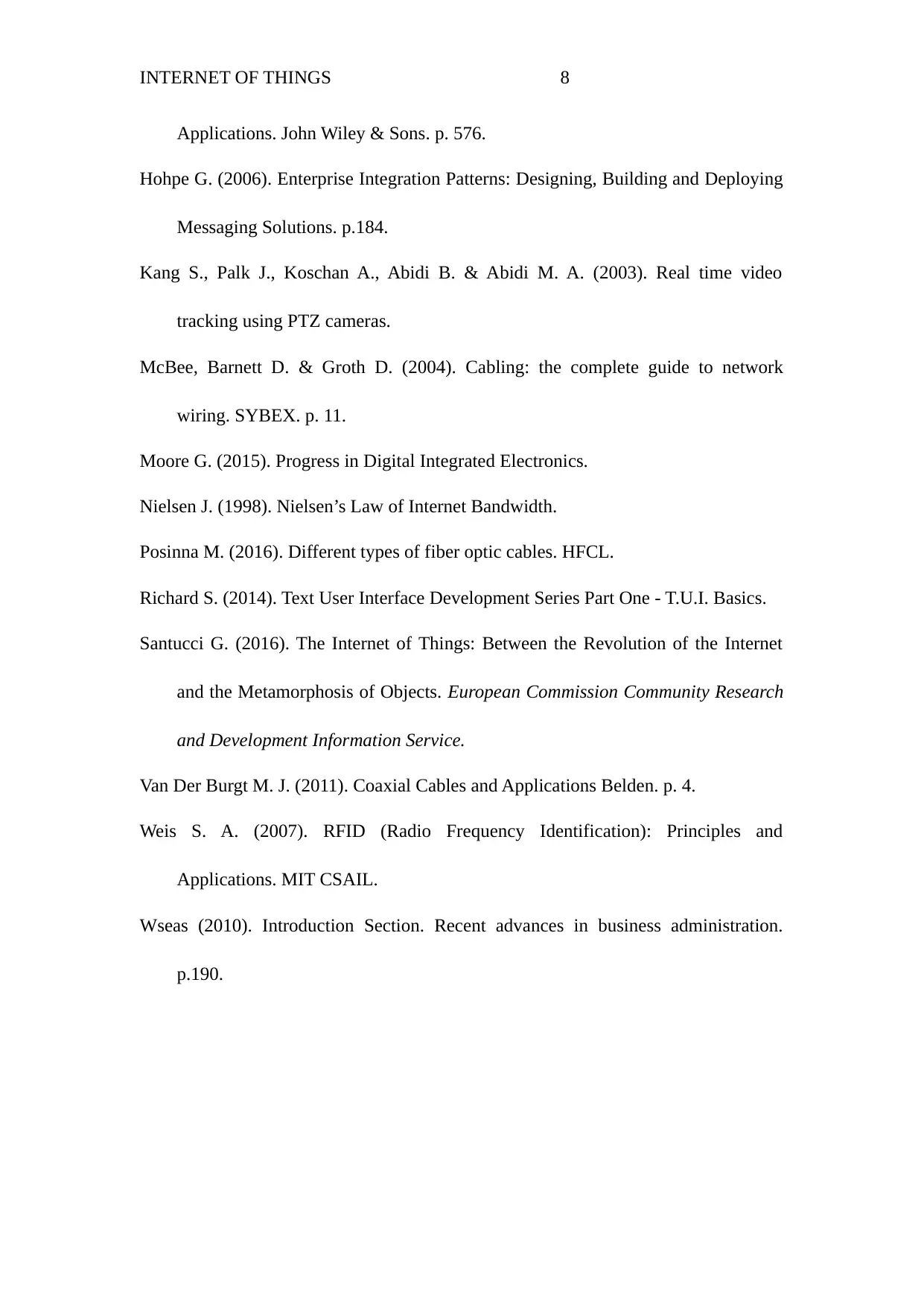
8INTERNET OF THINGS
Applications. John Wiley & Sons. p. 576.
Hohpe G. (2006). Enterprise Integration Patterns: Designing, Building and Deploying
Messaging Solutions. p.184.
Kang S., Palk J., Koschan A., Abidi B. & Abidi M. A. (2003). Real time video
tracking using PTZ cameras.
McBee, Barnett D. & Groth D. (2004). Cabling: the complete guide to network
wiring. SYBEX. p. 11.
Moore G. (2015). Progress in Digital Integrated Electronics.
Nielsen J. (1998). Nielsen’s Law of Internet Bandwidth.
Posinna M. (2016). Different types of fiber optic cables. HFCL.
Richard S. (2014). Text User Interface Development Series Part One - T.U.I. Basics.
Santucci G. (2016). The Internet of Things: Between the Revolution of the Internet
and the Metamorphosis of Objects. European Commission Community Research
and Development Information Service.
Van Der Burgt M. J. (2011). Coaxial Cables and Applications Belden. p. 4.
Weis S. A. (2007). RFID (Radio Frequency Identification): Principles and
Applications. MIT CSAIL.
Wseas (2010). Introduction Section. Recent advances in business administration.
p.190.
Applications. John Wiley & Sons. p. 576.
Hohpe G. (2006). Enterprise Integration Patterns: Designing, Building and Deploying
Messaging Solutions. p.184.
Kang S., Palk J., Koschan A., Abidi B. & Abidi M. A. (2003). Real time video
tracking using PTZ cameras.
McBee, Barnett D. & Groth D. (2004). Cabling: the complete guide to network
wiring. SYBEX. p. 11.
Moore G. (2015). Progress in Digital Integrated Electronics.
Nielsen J. (1998). Nielsen’s Law of Internet Bandwidth.
Posinna M. (2016). Different types of fiber optic cables. HFCL.
Richard S. (2014). Text User Interface Development Series Part One - T.U.I. Basics.
Santucci G. (2016). The Internet of Things: Between the Revolution of the Internet
and the Metamorphosis of Objects. European Commission Community Research
and Development Information Service.
Van Der Burgt M. J. (2011). Coaxial Cables and Applications Belden. p. 4.
Weis S. A. (2007). RFID (Radio Frequency Identification): Principles and
Applications. MIT CSAIL.
Wseas (2010). Introduction Section. Recent advances in business administration.
p.190.
1 out of 8
Related Documents
Your All-in-One AI-Powered Toolkit for Academic Success.
+13062052269
info@desklib.com
Available 24*7 on WhatsApp / Email
![[object Object]](/_next/static/media/star-bottom.7253800d.svg)
Unlock your academic potential
Copyright © 2020–2025 A2Z Services. All Rights Reserved. Developed and managed by ZUCOL.





